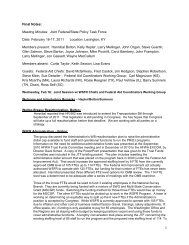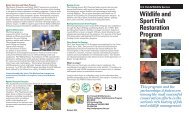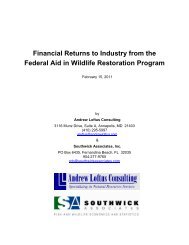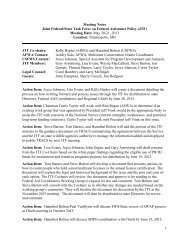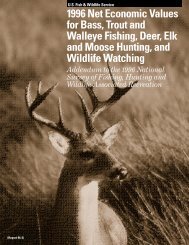Program Update - Wildlife and Sport Fish Restoration Program - U.S. ...
Program Update - Wildlife and Sport Fish Restoration Program - U.S. ...
Program Update - Wildlife and Sport Fish Restoration Program - U.S. ...
You also want an ePaper? Increase the reach of your titles
YUMPU automatically turns print PDFs into web optimized ePapers that Google loves.
Highlights from<br />
Region 3<br />
<strong>Wildlife</strong><br />
<strong>Restoration</strong><br />
Bottoml<strong>and</strong> Forest <strong>Restoration</strong> in Illinois<br />
by Kathy Andrews<br />
One of the largest, <strong>and</strong> longest running Pittman Robertson <strong>Wildlife</strong> <strong>Restoration</strong><br />
Act projects in Illinois is the Statewide Public L<strong>and</strong>s <strong>Wildlife</strong> Habitat Development<br />
Project, initiated in 1962 <strong>and</strong> known commonly as W-76-D. The goals of the project<br />
are to create wildlife habitat on public l<strong>and</strong>s, provide facility access <strong>and</strong> recreation<br />
opportunities, <strong>and</strong> establish wildlife management demonstration areas for Illinois<br />
citizens.<br />
Paul Willms, project manager for the Illinois DNR’s Division of <strong>Wildlife</strong> Resources,<br />
has been involved with the project for 34 years <strong>and</strong> coordinates development of<br />
the on-going 6-year plans for each of the 83 DNR sites currently participating in<br />
the project. The Service’s Region 3 presented an award to Mr. Willms in March<br />
2008 honoring him for his long term excellence in development, leadership <strong>and</strong><br />
administration of the W-76-D project.<br />
“The number of people contributing to the development <strong>and</strong> implementation of each<br />
plan is astounding,” Willms said. “From within DNR you have the l<strong>and</strong> manager <strong>and</strong><br />
the district wildlife biologist, forester <strong>and</strong> heritage biologist, <strong>and</strong> then you factor in the<br />
role of constituent groups <strong>and</strong> other l<strong>and</strong> management agencies. The knowledge <strong>and</strong><br />
enthusiasm these folks have really shows in the amount of on-the-ground work they<br />
are able to accomplish each year.”<br />
The Cache River State Natural Area contains 1,000-year-old bald cypress trees,<br />
Illinois’ largest natural area <strong>and</strong> largest dedicated nature preserve-<strong>and</strong> 18 parking<br />
lots constructed through the project that are designed to provide hunter access to<br />
more than 11,800 acres of prime squirrel, deer <strong>and</strong> duck habitat. For the majority<br />
of the year, these lots provide the hiker, birder, photographer <strong>and</strong> nature enthusiast<br />
access to incredible sights <strong>and</strong> sounds of the river system.<br />
“Management <strong>and</strong> restoration of the Cache River is a work in progress involving<br />
DNR, The Nature Conservancy, U.S. <strong>Fish</strong> <strong>and</strong> <strong>Wildlife</strong> Service, <strong>and</strong> Ducks Unlimited,<br />
with support from NRCS, Southern Illinois University-Carbondale, Friends of the<br />
Cache River, Citizens Committee to Save the Cache River <strong>and</strong> other local constituency<br />
groups,” said Jim Waycuilis, site superintendent of the 14,314-acre site spanning<br />
Johnson <strong>and</strong> Pulaski counties in southern Illinois.<br />
At monthly meetings, partners discuss how to maximize efforts <strong>and</strong> leverage funds for<br />
restoration of the unique bottoml<strong>and</strong> forest <strong>and</strong> river ecosystems.<br />
“One of the largest accomplishments within the boundaries of the Cache River project<br />
is the reforestation of l<strong>and</strong>s that were cleared <strong>and</strong> drained throughout much of the last<br />
two centuries,” said Mark Guetersloh, district heritage biologist with Illinois DNR.<br />
“Since 1991, more than 601,000 seedlings have been planted on 1,560 acres, <strong>and</strong> almost<br />
2,000 acres of wetl<strong>and</strong>s restored on public <strong>and</strong> private l<strong>and</strong>s within the watershed, due<br />
in large part to support from the State’s Conservation 2000 program <strong>and</strong> the W-76-D<br />
project.”<br />
The W-76-D projects implemented at the Cache River SNA also are an excellent<br />
example of how cooperative efforts –– development of wetl<strong>and</strong>s, removal of exotic<br />
species, trail development, planting of warm-season grasses –– between biologists<br />
with different specialties can have profound benefits for both game <strong>and</strong> nongame<br />
species.<br />
<strong>Wildlife</strong> <strong>and</strong> <strong>Sport</strong> <strong>Fish</strong> <strong>Program</strong> <strong>Update</strong> September 2008 25




